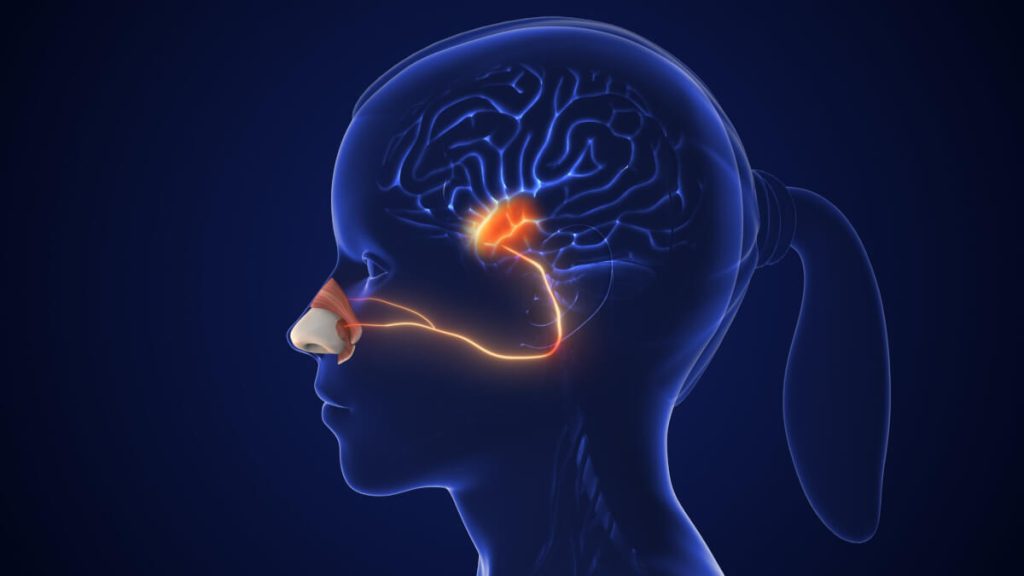

The olfactory sensory nerve pathway for smell detection. (JitendraJadhav/Shutterstock)
Mouse model reveals what triggers fast neural response
COLD SPRING HARBOR, N.Y. — The brain’s ability to rapidly adapt to changing rules is crucial for survival, yet scientists have struggled to understand exactly how this works. A study has now identified a neural feedback loop that acts like a high-speed update system, allowing animals to quickly adjust their behavior when familiar patterns change. This finding could help explain how human brains stay flexible in changing environments.
The study, published in Nature Communications, was conducted by scientists at Cold Spring Harbor Laboratory and the Transylvanian Institute of Neuroscience. They have discovered a feedback system in the brain that helps mice quickly learn and adapt when reward rules change. This system works like a high-speed communication network between two brain regions. One region processes smells, and another handles initial sensory information.
“In nature, animals are faced with different rules of engagement,” explains Cold Spring Harbor Laboratory professor Florin Albeanu, in a statement. “Sometimes, the same stimuli mean different things depending on context. Therefore, it’s not so unusual that you have to act on these different rules and assess what action you have to take.”
The research team trained mice to respond to simple cues, either a specific smell or a particular sound, to receive water rewards. Sometimes a smell meant “go get water” while a sound meant “wait,” but these rules would switch without warning. The mice had to figure out when the rules had changed and adjust their behavior accordingly.


This ability to adapt to changing rules is crucial for survival in the natural world. Animals need to constantly update their understanding of their environment; a food source that was safe yesterday might be dangerous today, or a sound that once signaled danger might now indicate a reward.
Using specialized microscopes, researchers watched brain circuits in action as mice performed these tasks. They focused on a connection between two brain regions: the piriform cortex, which processes smells, and the olfactory bulb, which receives initial smell information. This connection allows brain regions to communicate with each other about incoming sensory information.
Before this study, scientists thought these brain regions only dealt with smell processing. The most surprising finding was that these smell-processing regions also handled information about sounds and rewards.
“The animal is able to extract this change. Within a few seconds, it’s going to act in a way that is consistent with understanding,” says Albeanu. “Interestingly, we observed that top-down signals, which originate in the olfactory cortex, convey information about the reward value of the stimulus to the olfactory bulb—irrespective of them being sound or odor.”


Albeanu lab/CSHL)
The mice became quite good at this challenge. After learning the task, they could change their behavior within about seven tries when the rules switched. Their brain circuits showed similarly quick changes, suggesting these connections help animals adapt to new situations.
This rapid adaptation is remarkable considering how complex the brain’s task is. The brain needs to recognize that a rule has changed, suppress the old behavior pattern, and implement a new one, all while continuing to process incoming sensory information and make decisions about how to respond.
To test the importance of this brain circuit, researchers temporarily turned it off using light-sensitive proteins. When they did this, the mice had much more trouble performing the task correctly, showing that this circuit plays a key role in helping animals adapt to changing rules.
The study also challenges previous assumptions about how sensory information is processed in the brain. Rather than having strictly separated circuits for different senses, the brain appears to use shared circuits that can process multiple types of information based on current needs and goals.
The research team used several innovative techniques to conduct their study. They engineered mice’s brain cells to produce fluorescent proteins that change brightness when neurons are active. By implanting a tiny window in the skull, they could watch these neurons in action through a microscope while the mice performed their tasks. This allowed them to see exactly how brain circuits changed their activity patterns when rules switched.
Looking ahead, the researchers are investigating whether similar flexibility exists in other sensory systems. They want to know if the brain uses comparable feedback loops for processing visual information or touch sensations. Understanding these mechanisms could help develop better treatments for conditions where behavioral flexibility is impaired.
This discovery opens up new questions about how our brains process different types of information. The researchers are now investigating whether this same circuit might also handle other senses like sight and touch, what Albeanu calls “a universe of possibilities” for understanding how brains make sense of the world.
Paper Summary
Methodology
The researchers used a combination of genetic tools and advanced microscopy to observe neural activity in living mouse brains. They specifically engineered neurons to produce fluorescent proteins that change brightness based on neural activity. Using specialized microscopes, they could watch these neurons in action through a small window implanted in the skull. This allowed them to observe neural activity in real-time as mice performed the behavioral task.
Results
The study found that neural feedback connections rapidly changed their activity patterns when reward rules changed, often within seconds. These changes preceded and predicted successful behavioral adaptation. When researchers disabled these connections, mice performed significantly worse at the task, with success rates dropping from about 80% to around 65%.
Limitations
The study was conducted only in male mice, so findings may not generalize across sexes or species. Additionally, while the researchers could observe and manipulate neural activity, they couldn’t determine exactly how these circuits interact with other brain regions involved in decision-making and reward processing.
Discussion and Takeaways
This research reveals that sensory processing in the brain is more flexible and integrated than previously thought. Rather than having dedicated circuits for each sense, the brain appears to use shared circuits to process different types of information based on current needs and goals.
Funding and Disclosures
The research was supported by various grants including NSF IOS-1656830 and NIH R01DC014487-03, along with additional funding from Romanian National Authority for Scientific Research and Innovation CNCS-UEFISCDI.
Publication Information
The study was published in Nature Communications (Volume 16, Article 937) in 2025. It is titled, “Fast updating feedback from piriform cortex to the olfactory bulb relays multimodal identity and reward contingency signals during rule-reversal.” Authors include Diego E. Hernandez, Andrei Ciuparu, Pedro Garcia da Silva, Cristina M. Velasquez, Benjamin Rebouillat, Michael D. Gross, Martin B. Davis, Honggoo Chae, Raul C. Muresan, and Dinu F. Albeanu.








